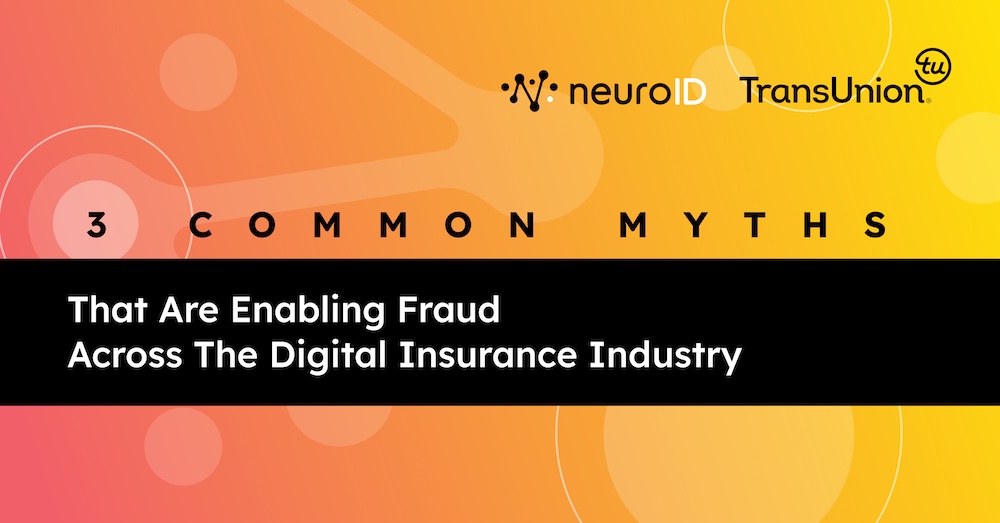
3 Common Myths that Are Enabling Fraud Across the Digital Insurance Industry
Insurers are quickly adapting to the digital age, as online quoting and customer service have become standard for success. But now, traditionally non-digital processes are also being brought into the digitization fold—often without a thorough look at the inherent risks of this evolution, or an updated assessment of the digital fraud landscape.
Case in point: according to the TransUnion’s recent Fraud Trends – Quarterly Analysis Report, the suspected digital fraud rate attempts for insurers has gone up by 159.4% from Q1 2021 to Q1 2022 across the global industry. Meanwhile, most other industries have seen a huge downturn in fraud, as fraud prevention solutions catch up to the head-start that cybercriminals gained during the chaos of 2020’s large-scale pandemic-driven digital transformation.
With emerging digitization comes evolving fraud threats for insurance customers and companies alike. So let’s look at why fraud is surging in our industry, while reducing in other industries . . . and what we can do about it.
Mythbusting and Mindset Changing
Insurers had fraud prevention neatly tucked away into their claims divisions, which was mitigating overall risk and losses . . . until it wasn’t. Part of this gap is a mindset shift and recognition that we don’t know what we don’t know. For example, it’s long been accepted that digital quotes require friction-light customer experiences and fast turn-around times. So, to meet those expectations, insurers moved towards prefill, bindable quotes under 60 seconds and other friction-shortcuts . . . which in turn created more threats to the process as fraudsters found ways to exploit them. And now, we’re seeing a mindset shift as especially younger customers realize that friction = security. They worry that a process that is too easy will mean security that is too simplistic as well. Friction is no longer a frustration but an expectation.
In talking with digital insurance professionals and assessing the landscape, I’ve run into 3 universal misperceptions about fraud that I believe are heavy contributors to that 159% increase. Let’s look at how these myths might be hurting your fraud detection and prevention—and what to do about it.
Myth 1:
Fraud prevention is only important at point of claim.
Truth: Letting disingenuous applicants interact with your quote form is costly and could be a data breach risk
Point of claim is just one vector for fraud. But fraud can happen anywhere. Fraud can impact your insurance business at the very beginning on your digital quote, not just at claim. Insurance managers are accustomed to only thinking about fraud downstream, when it comes to suspicious claims. But with digital quotes more risk is seeping into the business, and so fraud mitigation needs to start BEFORE claim.
Today’s sophisticated fraud rings can begin attacks before data is even inputted into forms. For example, identity mining and phishing saw an increase of over 100% within the P&C insurance industry between 2020 and 2021.
Thinking of fraud as having a singular attack point at claim is dangerous, but is a common approach.
Myth 2:
I’m protected with identity authentication tools.
Truth: Identity is multifaceted and traditional authentication tools are ineffective against stolen or fabricated identities.
Just like with Myth 1, this is a holdover of simpler times. Identity authentication tools are one part of the puzzle, but they often don’t detect sophisticated fraud rings or synthetic identity attempts (where the identity is real, but doesn’t belong to the person claiming it).
This requires the management of different identity, fraud, and behavior capabilities—such as device intelligence, identity resolution, and behavioral analytics. This will arm you with the right insights to secure your digital transactions and provide a seamless customer experience.
Myth 3:
If the data in the quote form matches, the applicant is genuine.
Truth: Personal Identifiable Information (PII) is increasingly compromised, and is no longer a reliable source of telling friend from foe.
Synthetic identity fraud—which accounts for up to 80% of today’s fraud attempts—thrives on stolen PII (“synthetic identities” are those created by fraudsters that do not correspond to any real person, but contain bits and pieces of ‘real person’ PII . . . just enough to get them past traditional identity verification systems that match PII to identities). PII is not the gold standard it used to be, for any industry, but many still think of it as the singular foundation of fraud prevention.
The best identity fraud defense requires a holistic approach that layers and optimizes friction as a tool to both predict fraudulent intent and optimize downstream expenses in a way that balances fraud detection and a positive customer experience. Fraud attacks go way beyond what they used to be—fraud prevention needs to go beyond PII as well.
Myths Busted—Now What?
On the whole, the insurance industry is very risk averse. We’re used to analyzing trends and getting to a safe best practice solution. This risk-aversion isn’t a bad thing: it’s what keeps insurers successful. But fraud doesn’t stand still, and that 159% increase emphasizes that we don’t have time to observe for multiple quarters before making a decision on how to tackle fraud. Even if the complexity of systems within insurance makes quick decisions difficult, we need to readjust our mindsets about fraud if we want to keep evolving as fast as the cybercriminals. And we’re lucky in that this is a universal threat—there are proven solutions we can learn from within other industries.
NeuroID’s behavioral analytics are key to providing deep-data insights that help prevent fraud for insurers. By analyzing how data is inputted into forms in real-time, behavioral analytics enable insurers to target their verification tools on risky cases and provide less friction to known legitimate applicants.
Digital identity is multifaceted. It takes a multi-layered approach to detect bad actors and defend genuine customers. By providing a holistic look into a users’ interactions with online onboarding fields, behavioral analytics through NeuroID mitigates the risk that digital fraud poses to insurers’ bottomline, reputation, and operations.
Threading the online-needle between customer security, convenience, and privacy is no small feat. But it is a competitive and customer service imperative.
Interested in learning more about how we can help you stop fraud sooner? Drop us a line!



